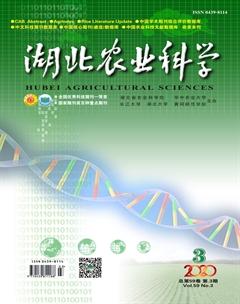基于主成分分析的粵北山區土地生態安全評價
馬俊偉



摘要:為評價研究粵北山區土地生態安全現狀,選用主成分分析方法,從資源環境壓力、土地利用狀態和社會經濟發展等方面選取了14個指標,以縣域行政區劃為評價單元構建評價指標體系,對粵北山區土地生態安全進行綜合評價。結果表明,粵北山區土地生態安全綜合得分為0.477 9,整體處于第Ⅲ級臨界安全水平,土地生態安全等級在空間分布上呈西高東低的區域差異;人口密度和經濟發展水平是影響粵北山區土地生態安全的主要因素,與土地生態安全等級呈負相關關系。
關鍵詞:土地生態安全;主成分分析;粵北山區
中圖分類號:F301.2;X826? ? ? ? ?文獻標識碼:A
文章編號:0439-8114(2020)03-0048-05
DOI:10.14088/j.cnki.issn0439-8114.2020.03.010
Evaluation on land ecological security in mountains of northern
Guangdong province based on principal component analysis
MA Jun-wei
(College of Public Administration,South China University of Technology,Guangzhou 510641,China)
Abstract: In order to explore the status of land ecological security in mountainous of northern Guangdong province, 14 indicators from the aspects of resource and environmental pressure, land use status and social economic development were selected by the principal component analysis method, then the evaluation index system with county administrative division as evaluation unit was built to comprehensively evaluate the land ecological security in the mountainous of northern Guangdong province. The results showed that the comprehensive score of land ecological security in the mountainous of northern Guangdong province was 0.477 9, which was in the level Ⅲ, critical safety. The spatial ecological security level of this area showed the regional difference that west was high and east was low in spatial distribution. Population density and economic development level were the main factors affecting the ecological security of mountainous in northern Guangdong province, and have a negative correlation with the level of land ecological security.
Key words: land ecological security; principal component analysis; mountainous of northern Guangdong province
20世紀80年代后期,人類活動導致生態環境惡化并帶來了嚴重后果,首次引起了人們對生態安全問題的思考[1]。在當今全球化進程加快,全球性的生態環境問題突出,人類生存和可持續發展面臨嚴峻挑戰的背景下,生態安全問題更是被高度重視。土地資源是生態環境系統的重要構成[2],土地生態安全是指生態系統結構穩定、功能全面,能夠有效服務于人類社會經濟的持續發展。
土地生態安全評價作為土地生態安全研究的重要組成部分,是土地生態安全量化研究的基礎[3],目前已有豐富的研究積累。學者們關于其基礎理論的探討包括人地關系理論[4]、可持續發展理論[5]和景觀生態學理論[6];在評價指標的選擇上多基于綜合性、科學性和簡潔性原則選取能夠反映社會、經濟和生態環境的數據構建評價體系[7,8];目前評價方法已經趨于完善,廣泛采用的方法有主成分分析法[9]、綜合指數法[10]、物元分析法[11]、灰色關聯法[12]等;評價的尺度包括宏觀尺度和微觀尺度,前者主要以行政區域、流域、保護區等為評價單元[13,14],后者以格網為評價單元[2]。為進一步豐富區域典型案例研究,本研究以發達省份欠發達地區粵北山區為對象,以縣域為評價單元,對其土地生態安全狀況進行了探討。
1? 研究區概況與方法
1.1? 研究區概況
粵北山區指廣東省北部范圍內的清遠、韶關、河源、梅州4個地級市,4市下轄湞江區、清城區等共32個縣(市、區)。位于北緯111°55′—116°56′、東經23°10′—25°31′,東鄰福建省,北接湖南、江西兩省,西部毗鄰廣西壯族自治區,南與珠三角地區接壤,是廣東與省外各界交流的“門戶”所在。粵北山區土地面積6.9萬km2,占廣東省總面積的38.4%,戶籍人口為1 424.38萬人。地區生產總值4 464.09億元,占全省地區生產總值的5.6%。經濟發展水平滯后的客觀現實決定了粵北山區在當下需要加大投入發展區域經濟。作為廣東省的生態保護屏障,粵北山區有著豐富的自然資源,但長期以來產業結構不合理,資源利用粗放、效率低下,區域生態安全問題突出。隨著經濟發展進程的加快,日漸增多的生產開發建設活動將極大提高區域土地利用強度,區域土地生態安全面臨嚴峻形勢。在粵北山區面臨經濟發展和生態保護雙重挑戰的背景下,研究其土地生態安全具有一定的現實意義。

